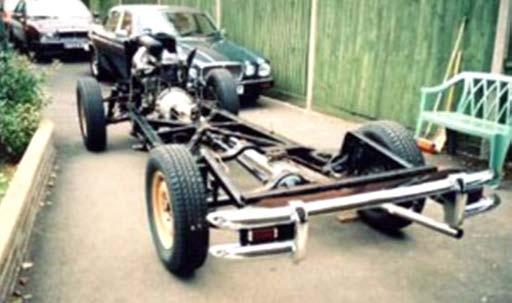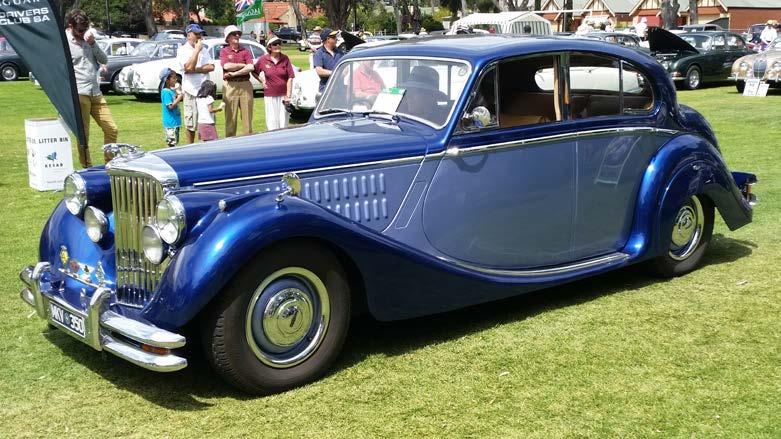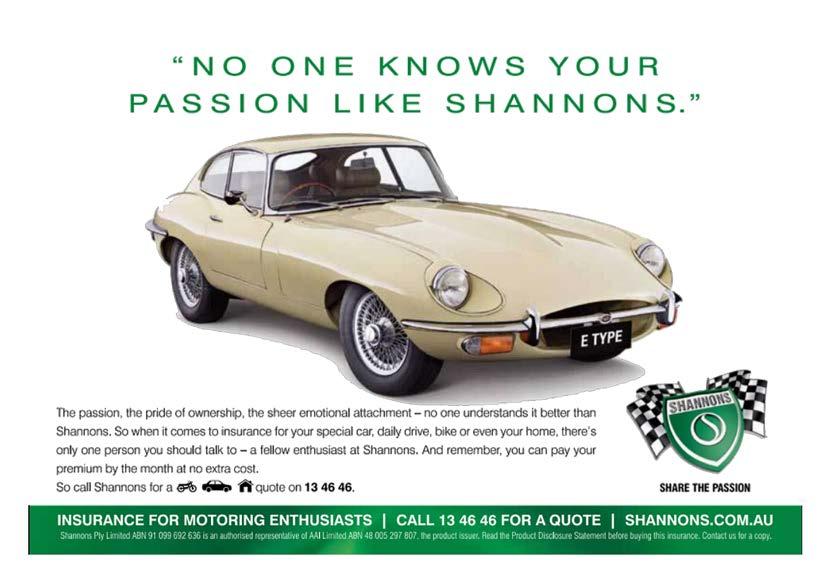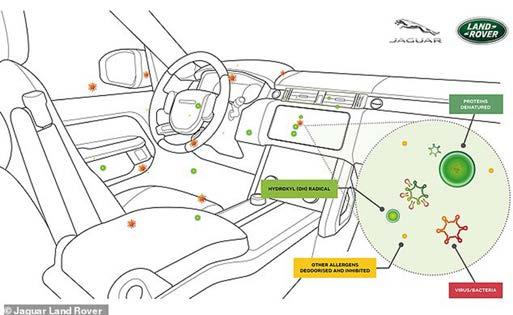
19 minute read
The Jag that Jack Built
Editor - The following story appeared in the November 2010 Edition of Classic Marque and has been reprinted with some additions and updates from Jack & Jean. PART 1 - The Purchase
My journey into classic cars began in the UK about 28 years ago when I purchased a silver Reliant Scimitar GTE for wife Jean’s birthday (known as the Princess Ann car). All went well until a few years later after an altercation with a Canadian driving on the wrong side of the road, whereby the car suffered a severely damaged front. We decided to do a complete body-off restoration and change the colour to British Racing Green. A total job of about one year. At that time Jean was PA to a company director who himself was into classic cars, MG’s to be precise, and when he saw the newly restored and painted car, he asked Jean if I would be interested in another project - an old Jaguar that was being restored, but restorer was himself terminally ill and would unfortunately not be around to finish it. I went to look at the Jaguar, in a very old barn. I was horrified. Everything that should have been on it was off it. The wings, doors, sunroof, boot lid, even the engine and gearbox were missing. The only things on were four wheels, body tub and petrol tank. At first, I thought no, too big a job, but was then informed that some of the body parts had already been repaired including the sills, three of the doors, three wings (luckily two were the front ones), the bonnet and boot. The engine was in pieces in several large boxes, but the block and head had been refurbished. I thought if the price was right, I might be tempted, and at €500 (approx $1,250) I was. In July 1996 1 paid €30 to a guy with a trailer to bring AFL 70 home. Jean bought me a genuine workshop manual and parts list for my birthday. I joined the UK JDC SS Register and would now try to get this car back on the road.
PART 2 - Restoration Begins
The first thing to do was to get everything in order. Luckily the previous restorer had labelled everything as he took it apart, so I boxed everything as appropriate - parts for the driver’s door, the boot lid, bonnet etc. The engine and gearbox were the first things I started on. I bought a full gasket set from the UK SS Register and following the workshop manual, set to work. Two weeks later the engine was completed - the only part was the gearbox drive for the rev counter. I sourced a used one through the club. I then attacked the water pump, carburettors, distributor and dynamo. Once they were all overhauled, I attached them. The gearbox was okay, just the selector rods freeing up in the top casing. Once this was done, I attached it to the engine, placed the engine on a trolley - task completed! Next job - the chassis. With two chain blocks I winched the tub up into the roof of my garage and pushed the chassis out into the carport, where it stayed for the next year while the work was being done to it. Everything was removed except for the bottom wishbones and torsion bars. The chassis was wire-brushed back to bare metal and then given two coats of metal primer and two coats of black weather-shield paint. All the shockers needed new rubbers, but apart from that they were in perfect working order. The brake master cylinder was beyond repair so a new one had to be bought. The wheel cylinders needed new seals, the brake pipes were all replaced (metal and rubber) and the brake shoes relined. A new petrol pump was needed and the petrol tank was sent for cleaning and plastic coated on the inside. The steering was then overhauled - steering box, top and bottom track rods and track rod ends, back axle rear springs re-bushed and the hand-brake cables sorted. Everything was de-rusted and painted and returned to the chassis. The wheels were painted and fitted with new radial tyres (not the town and country tyres that were on it when purchased — Jean thought they were tractor tyres). The engine and gearbox were then fitted.

PART 3 - Unfortunate Setback
Then fate reared its ugly head. In late 2000 1 started to get pain in my right leg (which previously had multiple fractures from a motorcycle accident in 1962). The pain turned out to be the onset of osteomyelitis in my tibia, which resulted in surgery to remove 20cm of the tibia and replace it with part of my fibula, and the leg was put in a framework for the next eight months so very little work was done until summer 2002.
PART 4 - Restoration Restarts
The only things I was capable of doing during my medical lay-off were the chrome work and woodwork. I had the chroming done at Premier Plating (the best chromers in our area) and as Greg the boss was an ardent fan of Jaguars, he did all the plating for me at a cheaper rate. The woodwork I did myself, and managed to get the veneer locally. All the damaged wood was removed and new veneer glued on and rubbed back. Many coats of Rustins Plastic Coating were applied (being rubbed back in between coats) and then a final polish - I was very pleased with the results. After I removed the body from the chassis it was lowered on to trestles so I could work underneath, but now I was reasonably mobile again and it was time to get to work. The floor and spare wheel compartment just needed de-rusting and painting, same as the chassis. Of the eight suspension points that mate up with the chassis, four had completely rusted away, along with their special bolts. I made a pattern in aluminium then had four made in mild steel, which I welded to the body. I made new bolts, had 20 thick rubber washers made and stuck them to the chassis. I then fitted a new stainless steel exhaust system, pushed it under the body and bolted the whole lot back together. I then assembled the doors one at a time with new window rubbers and then the boot lid and sun roof. Next job was to fit the radiator and tie rods which have the supports attached to hold up the front wings. After that little job I bolted on the wings, repaired the driver’s side rear wing and bolted both onto the body, then attacked the electrics. Luckily the wiring loom was in pretty good shape so, after replacing globes, checking wires and connections, everything worked except for the fuel gauge.
PART 5 - Move To Oz
In 2004 our daughter and her family informed us they were applying for immigration to Oz, and in December 2005 were successful. Jean and I both decided we would also try for immigration and in 2006 we too were successful. I closed my engraving business after 26 years and Jean retired and we got set for the move. When the container company came to see what we would be taking, No. 1 on my list was the Mk V. They said a 40ft container would do the job but the car had to be all together or I had to list all items not attached on a parts list. Luckily, we found this out just before my sonin-law Gary Williams left for Oz so he welded and leaded the right rear corner and sprayed it in primer, planning to finish the paint job in Oz. The next two months were spent putting everything on or in: carpets, seats, windows, bonnet and all chrome work so it was a whole car (theoretically) and in June I drove the Mk V 200 yards down the road and into a lorry to go and be put in the container along with our house contents for shipping. In August we followed.
PART 6 - The Final Leg
The Mk V was delivered to our home a month after we arrived as it had to have a separate import licence. The trouble with moving to a new house in a new country is that there is much work to be done. Acquiring transport, furniture, decorating the property - the list was endless. So yes, once again the MkV went into hibernation for about a year until household things were taken care of and then, hooray, I stripped the car apart again; all the interior, bonnet, chrome work, bumpers and windows. Where to start? Then I remembered the warning about overheating in SA so the water pump went to Bruce Fletcher for modification and the bonnet sides went to Lobethal to have new ones made with louvres. I then dealt with a few electrical problems: the fuel gauge and sender went for repairs, wires were run for the trafficators, window washers were wired in and the low-tone horn needed repairing. During this time, I saw an article in the JDC (UK) magazine of a MkV Drophead fitted with wire wheels, with the spats cut and shaped to miss the spinners. Jean said, Let’s do it to ours”, so I made a cardboard pattern and went back to Lobethal to have them modified. We loved the result; thought it made the rear look less bulky. Now the hard work started on rubbing back and filling all the paintwork, and after many hours of wet and dry my fingertips were totally smooth with no visible fingerprints. I masked up the car and the primer went on. It was then we decided on a colour charge from black and grey to two-tone blue, and Jean chose the final colours. My son-in-law Gary sprayed all the light blue first but did the darker blue in three (due to lack of space in the garage to do it all at once), then the clear coat was applied then even

more rubbing back - but the results were very pleasing. I then proceeded to put it back together and after many weeks work the car was ready to go to Jason’s for all the interior to be done: the headlining, door cards, carpets and seats. After six months I got the car back for Christmas 2009. Doctor Don Evans came in the New Year to check the tuning, carbies, brakes, then it was down to Bob Jane’s for tracking; the front was found to be 2 3/4 inches too high. Next trip was to Regency Park for registration, but on the way back we boiled up; it turned out the thermostat had stuck and split open. Don modified the housing to take a modern thermostat. When I went to register the car, I managed to get MKV 350, so goodbye to AFL 70.
PART 7 - Time for a Run
The first club run to Victor ended with the car being trailered home, where it was found that glass beads from when the head was overhauled in the UK had found their way into the oilway and got down No. I cylinder, seizing the rings and piston. The Mk V got home on Monday afternoon, and by Tuesday afternoon Dr Don had the engine stripped and all the pistons out on the bench. The following Monday the engine was back together and running. Don managed to hone out the damage in the bore but we needed a new piston and rings and the oil pump was damaged - but Bruce Fletcher had a decent one (among the eight in his garage). During this lay-up I sent my rev counter and speedo to Strathalbyn for overhaul; they are now rock-steady and even my clock is running. I have covered over 1,000 miles. We even attended the recent MK V Wagga run with no problems at all and enjoy being behind the wheel every time I go out in it. Would I take on a project like that again? Most definitely yes. I have just seen the advert in the JCCC for a Mk VII which uses the chassis etc of a Mk V, but I don’t think Jean would be very happy. But I can dream, can’t I? Then again, it is very satisfying to take a 1950 bag of bones and turn it into a classic car that I hope will still be running when I’m not. Thanks to all these people for their help: SA Auto Instruments, Lobethal Sheet Metal, NEAT Upholstery, All type paints, Chrome Masters, Fitch the Rubber Man, Garry Williams (son-inlaw) & All members of JCCC for help and information. And a special thanks to Dr Don Evans. Don, without your help knowledge over the past four years I don’t think my Mark V would be where it is now. It is greatly appreciated. And to Margaret for the endless cups of coffee and biscuits every time I called. My heartfelt thanks.
Continuation of The Jag that Jack Built.
From 2010 to 2018 Jean and I did the Border runs with the SS Register to Ballarat, Dubbo, Wagga and many other places. Apart from its first run to Victor Harbour (when the glass beads played havoc in the engine department), it never let us down. Back in the 90’s I was diagnosed with Rheumatoid Arthritis, which effects different parts of the body, mine has got progressively worse in my hands, shoulders and lower back, and eventually found it impossible to drive and having no power steering didn’t help. The car languished in the garage, still being polished and loved and I was trying to delay the inevitable of selling it, but sell it I did in October of 2020, a very sad day for me, but I have the memories and the photos. The new owner joined the JDCSA and I hope he has as much fun driving the Mark V as we did.
Jack & Jean Richardson.






Editor- I have been reading Magazine after Magazine to try and gauge what the industry and commentators believe is in store for Jaguar. The answer at this stage appears to be that no one except CEO Thierry Bolloré and his Directors really know what the future holds. And perhaps even they are not really sure as they are yet to provide a clear path forward. What we do know is that: • Jaguar will be the first established car manufacturer in the world to build nothing but electric vehicles (by 2025). • JLR has killed-off the all-new XJ electric sedan as well as the planned J-Pace that was to be built alongside the XJ. • Jaguar will become a full-blooded luxury brand, meaning it will be competing directly with Aston Martin,
Bentley, Mazerati, among others. • There will be no new Jaguars (other than updates) for 4 years. • JLR intend to move SUV’s away from
Jaguar and across to Land Rover. The last point will be of major significance to Jaguar dealerships, given that the F-Pace has been the best selling Jaguar model for several years. Next then the question is - what will be left for the dealers to sell without an SUV line-up? All that JLR is saying is that “Jaguar will emerge as a pure electric luxury brand with a dramatically beautiful new portfolio of emotionally engaging designs and pioneering next-generation technologies”. Along with the XJ’s death was the transfer of their MLA (Modular Longitudinal Architecture) to Land Rover. The MLA platform was designed to be used for either all-electric drive, plug-in hybrid or mild hybrid vehicles. It was the basis that all future Jaguars were to be built from (including the XJ). Replacing the MLA architecture will be a new pure BEV (battery electric vehicle) platform. Except, it doesn’t exist yet. And Jaguar won’t build one from scratch if they can help it, as it is a costly exercise for a brand that looks to scale back production by 25%. The problem with sharing a platform is that it hands Jaguar designers with an existing platform which they have no input. This could potentially hinder their designs in many ways. However, JLR head of design, Gerry McGovern, emphasized the “need to look for opportunities out there in terms of architectures that we could utilize or refine to give the stunning jaw-dropping Jaguars I’m talking about.” At least he is still positive. Finally I turned to UK Jaguar Enthusiast Magazine and the Paul Skilleter Column. Paul stated that the announcement confirms former hints that Jaguar will become, in effect, a niche flagship brand. In other words, just as he (Paul) had hoped, the pursuit of volume has at last been abandoned and within four short years from now, the marque will return to the low-volume, demand-led, specialist-car sector where Sir William Lyons had always intended it to be. As the release hints, maybe without the need to meet lowest-common denominator requirements, this will allow more imaginative and adventurous designs which will once again set the pulse racing. As a high-placed Jaguar executive said to Paul, “It is time to fix Jaguar and make it shine again.” We all hope they are right. . More information can be found in latest edition of Jaguar Australia Magazine.

2021 XJ cancelled as Jaguar move to its own BEV platform with what JLR claim will be stunning jaw-dropping designs.
JLR Aircon Unit to KILL 97% of Viruses and Bacteria
Jaguar Land Rover has developed a car air conditioning system which it claims can protect against coronavirus. Independent tests claim the new airpurification technology inhibits viruses and bacteria by as much as 97 per cent. JLR say it also removes pollen and other allergy-inducing substances, as well as those which create bad smells and unpleasant odours. This system, which the company codeveloped with Japanese electronics giant Panasonic, employs the use of their nanoe X technology and is said to be ten times more effective than the existing technology in purifying cabin air. It will be used in the cabins of future Jaguar,



A former Australian racing driver and Jaguar collector, Scott Shearman, lost £150k to rogue salesman, Scott Nicolson, after trusting him to locate and restore a vintage E-Type. A court heard Nicolson would send regular updates to clients showing progress being made on the restoration of vehicles they were paying for. But in some cases, the cars were not Nicolson’s to sell and belonged to other clients. It was only after his company, Barbary Hill, went into administration in 2018 that customers discovered they had been left out of pocket by a total of over £400,000. Scott Shearman is such a fan of Jaguar that he bought Wappenbury Hall in Warwickshire, the country estate which was home to the British marque’s founder Sir William Lyons for more than 50 years. Scott had planned to display the 1961 E-Type as part of his collection of classic cars at the £3.6 million estate, but within weeks of paying for the E-Type, Barbary Hill went into administration. Prosecutors told Lincoln Crown Court the firm would ‘source, purchase and restore classic Jaguar motor vehicles’ from around the world, with Nicolson retaining possession of them until restoration was complete. They said Nicolson, 45, had employed the grandson of former Jaguar chief engineer Bill Haynes, which ‘no doubt led Jaguar aficionados to take their custom to Barbary Hill’. Prosecutors added that, while William Haynes had ‘intimate knowledge’ of Jaguar vehicles and oversaw the restoration workshop, he had no involvement in the finances of the company and was unaware of Nicolson’s offending. The court heard another client, who had bought a Jaguar from Barbary Hill as an investment for his pension, paid £98,150 for one of the cars, only to find Nicolson sold it to a buyer in Portugal. A third client handed over a £50,000 deposit for the purchase and restoration of a classic Jaguar as a Christmas present, only to discover he was out of pocket when administrators notified him the firm had gone under. Neil Sands, defending Nicolson, said the money has not gone on a luxury lifestyle. He lives in a rented house. He doesn’t have luxury foreign holidays, a speed boat or anything like that.’ Nicolson, 45, of Witham St Hughs, Lincolnshire, admitted two charges of theft and two charges of fraud. He was jailed for three years-seven months. His benefit from crime was assessed at £409,146 but he was ruled to have no available assets and was ordered to pay a nominal sum of £1 under the Proceeds of Crime Act, meaning his victims will not receive any compensation. .

Australian Scott Shearman is such a fan of Jaguar that he bought Wappenbury Hall estate, the former home of Sir William Lyons.
Jaguar C-X75 To Be Reborn - Again
A Hungarian company named Kincsem plans to take the Ian Callum-designed C-X75 and build it into something you can actually buy. The name Kincsem comes from an unbeaten race horse from the 1800s that won 54 out of 54 races, and means “my treasure” in Hungarian. The beautiful design was resurrected for the James Bond film “Spectre”, but was never intended to be sold to the public. Instead, those ones were fitted with V8 engines to make them driveable. The original concept was powered by four electric motors, one on each of the wheels, with a pair of microturbines acting as a range extender. The Kincsem HyperGT will follow a similar powertrain design as the concept, but instead of microturbines, a conventional internal combustion engine will be onboard as a range extender. Kincsem was founded by Tibor Bak, who seeks to fuse the world’s best talent with the latest technology to develop beautifully- designed, high-performance products and now involves none other than Ian Callum, former Aston Martin and Jaguar designer and all-round design legend. Ian Callum and his standalone company are just the first of high-profile partnerships coming to Kincsem, though it didn’t disclose the others. The Kincsem Hyper-GT will be built in the UK, and aims to start production sometime in 2023. .











